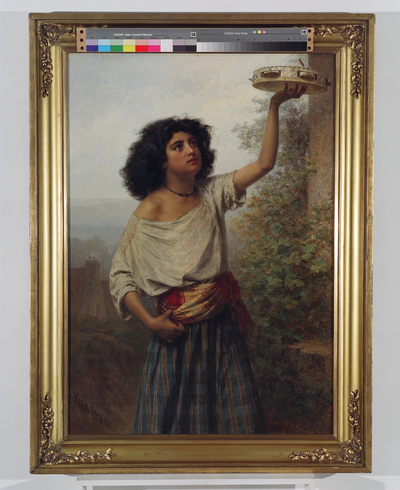Javascript must be enabled to continue!
Young Gypsy Woman
View through Europeana Collections
In 1870, after successfully taking part in the Paris Salon, Kārlis Huns went to Normandy and then to Belgium where, it is thought, he painted the “Young Gypsy Woman”. This type of work by the artist – single figure genre compositions – was highly regarded. The fragile figure of the young gypsy, her pleading gaze, the raised tambourine against the falling coin – all the elements add up to a concentrated and sympathy evoking narrative, in which a social tint has been added to the romantic motif. In line with the academic tradition, everything in the painting has been carefully considered and purposefully realised using the artistic means of expression available to the author.
Title: Young Gypsy Woman
Description:
In 1870, after successfully taking part in the Paris Salon, Kārlis Huns went to Normandy and then to Belgium where, it is thought, he painted the “Young Gypsy Woman”.
This type of work by the artist – single figure genre compositions – was highly regarded.
The fragile figure of the young gypsy, her pleading gaze, the raised tambourine against the falling coin – all the elements add up to a concentrated and sympathy evoking narrative, in which a social tint has been added to the romantic motif.
In line with the academic tradition, everything in the painting has been carefully considered and purposefully realised using the artistic means of expression available to the author.
Related Results
Sketchbook
Sketchbook
Sketchbook with black-leather-covered cardboard covers. Sewn page block; pages of off-white wove paper, each 27.2 x 20.8 cm. Drawings made in graphite and in vertical orientation...
Pelike depicting Helen and Paris
Pelike depicting Helen and Paris
The scene on the front of the pelike (jar) comprises five figures: a couple consisting of a woman and a young man, flanked by a boy and second woman, respectively. A small Eros flu...
Sketchbook
Sketchbook
Sketchbook with black-leather-covered cardboard covers. Sewn page block. Pages of white wove paper, each 34.7 x 27.1 cm. Pages numbered at l.l. of verso in graphite. Drawings i...
Mary Squires, a gypsy renowned for her ugliness. Engraving.
Mary Squires, a gypsy renowned for her ugliness. Engraving.
Lettering: Mary Squires the gypsy....
Woman Committing Sati, folio from an Album
Woman Committing Sati, folio from an Album
This painting dramatically represents a young woman about to commit sati, or self-immolation. The literary subject of a woman’s sacrificing herself on the funeral pyre of her dead ...
Column Krater (bowl for mixing wine and water): Komos Scene
Column Krater (bowl for mixing wine and water): Komos Scene
On one side, two nude women, both wearing headdresses and adorned with earrings and necklaces are chased by two men nude men. The woman on the right holds a wine cup (skyphos) in h...
Village in Martinique (Femmes et Chevre dans le village)
Village in Martinique (Femmes et Chevre dans le village)
In 1887, Gauguin and Charles Laval went to Panama, and then to Martinique, searching for a warm, healthy climate and a cheap place to live a natural, "savage" life. Residing during...
Woman at the Window
Woman at the Window
The nineteenth century witnessed the evolution of the nuclear family unit—father, mother, and children—into a nexus of bourgeois social life throughout Europe and North America. In...




